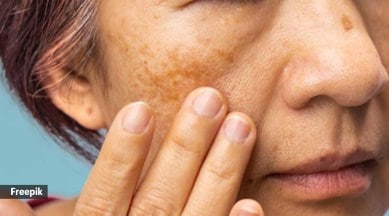📣 For more lifestyle news, click here to join our WhatsApp Channel and also follow us on Instagram
Everything you need to know about post-inflammatory hyperpigmentation
It is usually temporary and fades over time, but can persist for months or even years in some cases," said Dr Mandeep Singh, Head of Department, Plastic Surgery, Paras Health, Gurugram

As the name suggests, post-inflammatory hyperpigmentation (PIH) is a form of pigmentation that is caused due to inflammation. Usually, a response to inflammation such as acne or injury, this skin condition can affect the face as well as the entire body.
“PIH is more common in people with darker skin tones, as they have more active melanocytes (pigment-producing cells) in their skin. It is usually temporary and can fade over time, but can persist for months or even years in some cases,” said Dr Mandeep Singh, Head of Department, Plastic Surgery, Paras Health, Gurugram.
monthly limit of free stories.
with an Express account.
So, let’s understand the condition in detail.
What is it?
If you tend to tan easily, you probably get brown spots on your skin post any inflammation or injury to the skin. They can be pretty difficult to get rid of. These dark brown spots are known as PIH, Dr Kaveri Karhade, a dermatologist, wrote on Instagram.
Why does it happen?
People with high pigmented skin usually have increased melanin production, the pigment that gives colour to the skin. When the skin regenerates after inflammation or injury, the production of melanin is triggered and causes the dark spots, she added.
How to prevent it?
When it comes to PIH, like many other things, prevention is better than cure. If you do get pimples or any injury, do not pop or pick at them. If you think your acne or any other skin condition is re-occurring, then it is best to get them checked out by a dermatologist and treated, so that you can minimise the amount.
There are a number of solutions available to lighten hyperpigmented skin, as per Dr Singh:
*Sun protection: Wearing sunscreen every day can help prevent further darkening of the skin. Use broad-spectrum sunscreen with an SPF of at least 30 and reapply every two hours.
*Topical lightening agents: There are several over-the-counter (OTC) creams and serums that contain ingredients like hydroquinone, kojic acid, and vitamin C that can help lighten the skin. These products should be used consistently for several weeks to see results.
*Chemical peels: A chemical peel involves applying a solution to the skin to remove the top layer of skin cells. This can help to lighten the skin and improve its texture.
*Microdermabrasion: Microdermabrasion involves using a device to gently exfoliate the top layer of skin. This can help to improve the appearance of PIH.
*Laser therapy: Certain types of lasers can target and reduce the appearance of PIH. Laser therapy should be performed by a qualified professional.
Concluding, Dr Singh said, “It’s important to note that treating PIH can take time, and results may vary. It’s also important to consult with a dermatologist or healthcare provider before starting any new treatment regimen.”
📣 For more lifestyle news, follow us on Instagram | Twitter | Facebook and don’t miss out on the latest updates!
📣 For more lifestyle news, click here to join our WhatsApp Channel and also follow us on Instagram